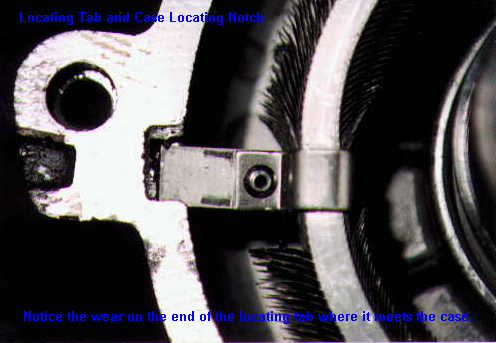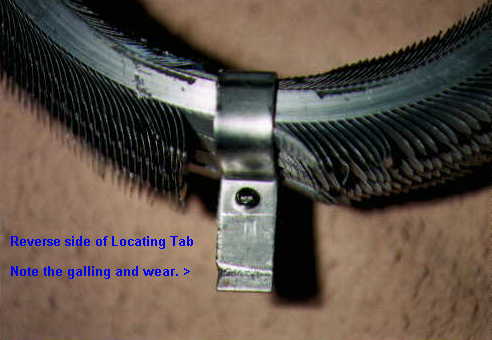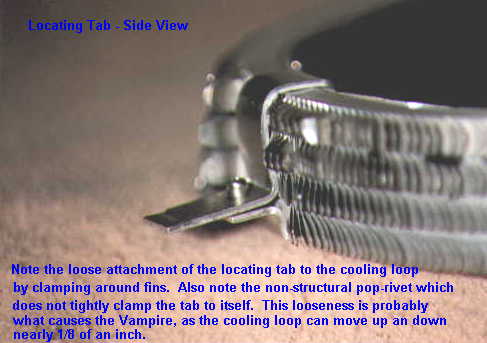| Forum | Marketplace | Knowledge Base | | H1 site | H2 site | H3 site | |
The Hummer Knowledge Base
|
 Here is a view of the locating tab in position in the notch milled in the mating surface of the front case half. This tab is designed to support the cooling loop, presumeably to prevent excessive stress on the very part of the loop which failed anyway.
 Here is a detail of the cooling loop locating tab. This view is from the side of the tab towards the front of the transfer case. Notice the galling on the face of the tab and the wear on the edge of the tab caused by vibration and movement of the tab in the locating notch.
 Here is a side view of the locating tab illustrating how it is mounted to the cooling loop. Note the gap between the surfaces where the pop-rivet is. Also, note that the locating tab is pressed around the cooling loop over the cooling fins. The combination of the loose rivet and the crushed fins allows the locating tab to move over 1/8 of an inch. Because the direction of movement of the tab is parallel to the longitudinal axis of the cooling loop, it allows the cooling loop to move and flex excessively under vibration, pressure and temperature. Because the end blocks which protrude through the transfer cast are bolted securely to the transfer case wall, and cannot turn or move, all of the movement in the cooling loop is focused on the soldered joints where the tube meets the end blocks. This obviously results in work-hardening and fatigue cracking of the tube at the point of attachment, causing the ATF Vampire. It is my opinion that this problem will most likely show up in high-mileage vehicles such as mine (it occurred at 60,000 miles) rather than low mileage ones, although at least one HML list member experienced it at very low (and fortunately for him, in warranty, mileage). I say this because I see the stresses on the cooling loop as occurring mostly at high speeds, where pressure, heat and vibration all combine to cause the loop to move around excessively. The more wear there is on the locating tab, the more movement there will be in the cooling loop, so this accelerates the problem. I suspect that many more HUMMER owners will begin to experience the Vampire as fleet miles begin to rise.
Unfortunately, at this point, there is no "official" recognition of the problem, much less any permanent fix for it. It's my opinion that the "quick and dirty" nature of the coolant loop locating tab indicates that AMG engineers are at least aware of the *potential* for fatigue-cracking of the coolant loop. Whether or not this problem is yet widely known in the commercial HUMMER fleet is hard to tell, since AMG is not forthcoming with any information or assistance so far. My experimental solution will include tack-welding the locating tab loop to the edges of the square coolant loop tube to create a solid join and hopefully prevent movement. (photos when I get them) I'm considering combining this with a small, threaded hole through the tab and into the case edge for a small countersunk screw, which should firmly fix the tab to the case as well. Hopefully, this will stop the flexing of the coolant tube and reduce the chances of stress fractures. There are a few concerns about this, the first being that locking the locating tab in the case notch may not be the best idea. This is because some flexing of the tube in response to temperature and pressure changes is normal, and it may be necessary for the tab to "float" in the notch so it can move in and out slightly. Another possible solution would be to "float" the cooling loop withing the transfer case by using a rubber bushing between the case and the loop hose nipples which would absorb vibration and allow the tube to move slightly without placing undue stress on the joint. This would reqire a bit more engineering to find the proper hole size and bushings. The second problem is the warranty issue. Although this defect appears (in my opinion) to be a clear design/manufacturing defect, it probably won't occur until well after the warranty is expired, as it did in my case, and the cost of repairing it, and rebuilding a destroyed transmission (like mine) may be placed on the owner's shoulders, unless and until AMG comes out with a recall notice and a fix. The problem is that if you modify your case before your warranty expires without AMG's blessing, they can, and most likely will refuse to cover any damage, since it has been modified without their approval. Which leave owners with no way to prevent the Vampire from striking until the warranty expires. So, proceed at your own risk if you choose to make any modifications. Another option for those owners who are concerned is to simply bypass the transfer case oil cooler loop by making a "U" shaped tube of steel which is inserted in the oil lines where they attach to the cooling loop, so that there is no oil being passed through the loop. Of course, this means that you won't have any transfer case cooling. I recommend that every HUMMER owner fabricate or obtain such a "bypass tube" and keep it in their vehicle "emergency parts box", so that if you are struck by the Vampire out in the boonies, you can disconnect the transfer case cooling loop, insert the bypass tube, top up the ATF and head home. Hopefully, AMG will investigate this problem and admit to a design defect, develop a fix and recall affected transfer cases for repair and extend warranty coverage for damage caused by the Vampire.
Well my truck just survived a vampire attack. My truck's a 95 with just under 40000 miles. The truck went in 3 times for transmission leak. I kept finding ATF dripping from the air filter drain thing-a-ma-bob forming 2 - 10 inches wide puddles. I kept topping off the ATF which saved my tranny. Fellow list member Tim Dzaman pointed me to the detailed vampire info on the data base. I took 8 pages with color pics to the dealership. Well it took me 6 phone calls to finally get them to open up the transfer case and check it out. They put varsol in the cooling loop and it all drained out so they put a new cooling loop in. I found a 1/4" crack exactly were Scott had described it to be. Quick things to look for:
If you find this, keep putting ATF in until you can get it repaired and do it soon or you'll loose your tranny.
Nick de Breyne
The info on this in the HID is all correct, but it is a bit dated. All new replacement coolers are now shipped with a small bracket that aids in installation of the new one. When you tighten the mounting nuts that fasten the cooler loop into the t-case, it is critical that the ends of the loop be supported such that they are not twisted or torqued when the nuts are tightened. The new bracket helps with this, but care is still required. Symptoms: Usually, the first sign of fluid is a dripping near the air filter, behind the right front tire. The fluid gets there through the sealed vent system. This is the only place the system is open, so it drips into the filter canister, and seeps out the dump valve. The first symptom of the vampire is usually that the tranny begins to slip. If this happens much, it is usually toast (the tranny, that is). A few people with the vampire do spill out the excess fluid. It sometimes comes out the rear seal on the T-case, and sometimes it pushes the "rubber plug" out of the side of the T-case. Both of these may indicate a kinked or plugged vent line, or a very large hole in the cooler loop. Dave
|
